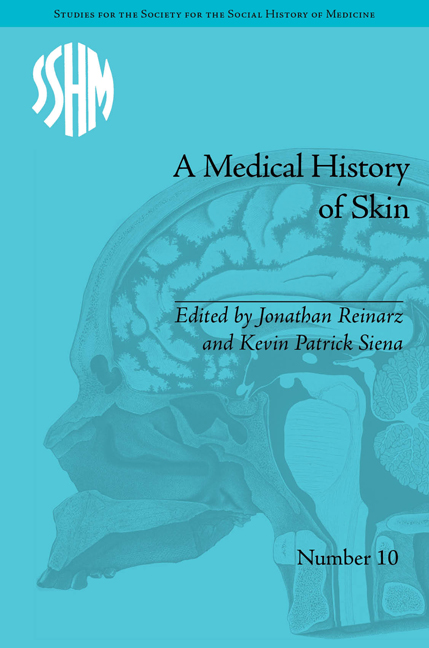Book contents
- Frontmatter
- CONTENTS
- List of Contributors
- List of Figures and Tables
- Scratching the Surface: An Introduction
- Part I The Emerging Skin Field
- Part II Skin, Stigma and Identity
- Part III Skin, Disease and Visual Culture
- 9 ‘An Alteration in the Human Countenance’: Inoculation, Vaccination and the Face of Smallpox in the Age of Jenner
- 10 Portraying Skin Disease: Robert Carswell's Dermatological Watercolours
- 11 Atavistic Marks and Risky Practices: The Tattoo in Medico-Legal Debate, 1850–1950
- 12 ‘Kissed by the Sun’: Tanning the Skin of the Sick with Light Therapeutics, c. 1890–1930
- 13 ‘Classic, Characteristic or Typical’: The Skin and the Visual Properties of External Anthrax Lesions
- Afterword: Reading the Skin, Discerning the Landscape: A Geo-historical Perspective of our Human Surface
- Notes
- Index
13 - ‘Classic, Characteristic or Typical’: The Skin and the Visual Properties of External Anthrax Lesions
from Part III - Skin, Disease and Visual Culture
- Frontmatter
- CONTENTS
- List of Contributors
- List of Figures and Tables
- Scratching the Surface: An Introduction
- Part I The Emerging Skin Field
- Part II Skin, Stigma and Identity
- Part III Skin, Disease and Visual Culture
- 9 ‘An Alteration in the Human Countenance’: Inoculation, Vaccination and the Face of Smallpox in the Age of Jenner
- 10 Portraying Skin Disease: Robert Carswell's Dermatological Watercolours
- 11 Atavistic Marks and Risky Practices: The Tattoo in Medico-Legal Debate, 1850–1950
- 12 ‘Kissed by the Sun’: Tanning the Skin of the Sick with Light Therapeutics, c. 1890–1930
- 13 ‘Classic, Characteristic or Typical’: The Skin and the Visual Properties of External Anthrax Lesions
- Afterword: Reading the Skin, Discerning the Landscape: A Geo-historical Perspective of our Human Surface
- Notes
- Index
Summary
The appearances [of external anthrax] are in the highest degree characteristic.
Cutaneous anthrax is associated with a characteristic skin lesion.
An examination of almost all recently published texts on pathology, industrial medicine and bacterial diseases reveals a common underlying assumption that the appearance of external anthrax is somehow distinctive and easily recognizable. In addition, this is not a new phenomenon, as the gap of 145 years between the two quotations above demonstrates; the idea of a ‘characteristic’ appearance for anthrax lesions on the skin was established long before a cause for the disease itself was identified. The pustules that indicate the presence of an anthrax infection in the skin are said to be large and almost exclusively black in colour. Nor is this a phenomenon restricted to contemporary descriptions of the disease: the French word for the disease, charbon, means ‘coal’, ‘charcoal’ or ‘carbon’, reflecting the colour of the external lesions. The association between anthrax pustules and their colour and general appearance is therefore one which earned the disease, and its supposedly characteristic pustules, its name. This view is deeply embedded within the visual culture of anthrax; as far back as the late fourteenth century, English texts referred to the ‘coal-fire’ appearance of the disease on human skin. Historians of medicine have likewise taken the nature of the pustules of external anthrax for granted. Studies addressing the visual properties of anthrax have largely focused on the causative organism – Bacillus anthracis – and the manner in which representations of this bacillus were exchanged between centres of research.
- Type
- Chapter
- Information
- A Medical History of SkinScratching the Surface, pp. 195 - 208Publisher: Pickering & ChattoFirst published in: 2014



